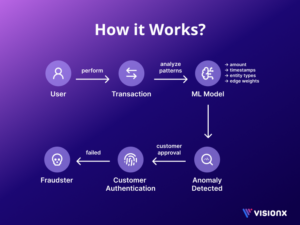Financial institutions today face a relentless challenge. The global economy loses billions annually due to malicious financial transactions and money laundering activities. In fact, the United Nations Office on Drugs and Crime (UNODC) estimates that money laundering accounts for 2-5% of global GDP, which translates to approximately $800 billion to $2 trillion each year
These figures make it clear that fintech companies need to strengthen their protective measures. In this blog, we explore the pain points in transaction fraud and money laundering and discuss how machine learning can revolutionize fraud detection and prevention.
The Growing Threat of Transaction Fraud
Malicious financial transactions come in many forms. Whether it’s a series of small deposits funneled from different accounts into one or a large sum drawn from various sources, these patterns are designed to slip past conventional security measures. When fraudsters work in small, discreet chunks, they often avoid immediate detection. On the other hand, massive transfers, especially when they involve multiple accounts, create a different set of challenges.
Financial institutions face enormous risks in their operations. Financial institutions confront massive financial losses alongside reputational damage and potential regulatory penalties. Sophisticated fraud schemes turn consumers’ hard-earned funds into financial losses. With traditional systems struggling to keep up, automation in fraud detection is no longer optional; it’s a necessity.
Why Automate Fraud Detection?
You might wonder: Why would a financial institution automate its fraud detection process? The answer is simple. Manual detection methods are slow, inefficient, and often outdated. Fraudsters continuously adapt, finding new loopholes in static systems. Automation powered by machine learning services and artificial intelligence offers the agility to learn, adapt, and respond in real time. This not only minimizes losses but also builds trust with customers who expect a secure financial environment.
Payment fraud detection and prevention heavily depend on automation. Institutions can quickly identify suspicious patterns through automation and execute preventive measures before extensive harm happens.
Types of Patterns in Malicious Transactions
Let’s break down how these malicious transactions work. Consider two common patterns:
- Smaller Chunks to One Account: Fraudsters may send small amounts from various accounts to one account. Individually, these transactions appear harmless. But when aggregated, they can signal a coordinated money laundering effort.
- Large Sums from Multiple Accounts: Another approach is to channel large sums from different accounts into a single target account. This method can be used to consolidate funds quickly before the activity is detected.
Graph data structures serve as the most effective means to capture complex account relationships because they enable visualization and analysis of these connections. Nodes represent accounts in a graph, while transactions function as edges that connect these nodes together. The network patterns detect anomalies that indicate fraudulent activities when analyzed.
Role of Machine Learning in Financial Fraud Detection
Machine learning has transformed how financial fraud detection operates. Conventional fraud detection systems depend too much on fixed rules, which modern fraudsters can successfully break through. Machine learning possesses the capability to learn from extensive datasets. The system learns from emerging patterns and updates its approach in response to the evolving strategies of fraudsters.
The financial technology space utilizes two primary methodologies.
- Traditional Machine Learning: Anomaly detection employs algorithms such as decision trees, logistic regression, and clustering methods. These methods show effectiveness in some cases but face difficulties with constantly changing financial transactions.
- Graph Neural Networks (GNNs): GNNs take advantage of the graph data structure to understand the intricate web of transactions. They can capture complex patterns that traditional models may miss. In our work, we trained a GNN model that reached 90% accuracy in detecting malicious financial transactions.
By using these models, financial institutions can not only detect fraudulent activities faster but also reduce false positives that can inconvenience genuine customers.
VisionX’s Journey: Creating a Machine Learning Model for Fraud Detection
Project Overview
Building a robust fraud detection model begins with a fundamental challenge: acquiring reliable and relevant data. In many domains, gathering data is relatively straightforward, but this is not the case for financial transactions. Financial data involving real people is often sensitive and heavily protected due to privacy concerns, making it difficult to obtain real-world transaction datasets.
Solution
VisionX found an innovative solution to our data scarcity problem. In 2024, IBM released a research paper titled ‘Anti-Money Laundering’ in which they used generative AI technology to produce anonymized synthetic financial transaction data. The synthetic data accurately represents real-world financial activities while maintaining user privacy and security protocols. Utilizing IBM’s synthetic data allowed VisionX to train the model without violating privacy standards.
Methodology
Once the synthetic data was gathered, our machine learning experts used graph data structures to model the complex relationships between transactions. Graphs are ideal for representing networks of interactions, allowing us to recreate common fraud patterns, such as small, repeated deposits into a single account or large, converging transfers from multiple accounts. These patterns are often indicative of fraudulent activity and can be effectively modeled using graph structures.
Some of the common patterns are:
- Max 10 hops
- 13 Degree Fan-In
- 16 Degree Fan-In
To efficiently analyze these patterns, we utilized Neo4j as our graph database, using its ability to represent complex transactional relationships as a network. We structured our data model to capture these patterns effectively, incorporating node attributes such as transaction amount, timestamps, entity types, and edge weights representing transaction frequency or volume.
This enriched graph data was then used as input for Graph Neural Networks (GNNs), enabling the model to learn complex transaction behaviors, detect anomalies, and predict potential fraudulent activity. We experimented with different GNN architectures, optimizing for accuracy and scalability in large-scale financial transaction datasets.

Model Development
With the graph structures in place, VisionX proceeded to train our fraud detection models. We experimented with both traditional machine learning algorithms and more advanced techniques, such as Graph Neural Networks (GNNs). The GNN model, in particular, demonstrated remarkable promise.
“Our machine learning model achieved an impressive 90% accuracy rate in predicting malicious financial transactions.”
Key Learning
This milestone underscores the effectiveness of synthetic data when generated correctly. Our results show that synthetic financial transaction data can serve as a reliable stand-in for real-world data, enabling the development of effective fraud detection systems. By using generative AI and graph-based models, VisionX created a solution that provides a high level of accuracy, helping to improve the identification of fraudulent activities in financial transactions.
“Our solution helps reduce fraud losses by 40%; a fintech company could potentially save anywhere from $10 million to $50 million per year.”
Transitioning from Proof of Concept to Real-World Applications
Our current model is a proof of concept (POC) that we are eager to test further. The next step is to apply our model to real-world data sets provided by financial institutions. The strong resemblance between our synthetic data and real-world data gives us confidence in achieving equivalent accuracy results during on-the-ground application.
How does synthetic data accuracy impact financial fraud detection using machine learning? Financial institutions now possess an exceptionally dependable tool for data analysis. Our model will achieve real-time anomaly detection capabilities after additional fine-tuning and validation processes. The system sends notifications to appropriate authorities, who can then promptly investigate and address deviations.
The Future of Financial Fraud Detection
The battle against financial fraud continues without end. The development of fraudster tactics requires the corresponding advancement of defensive measures. Graph neural network-based machine learning models lead the current advancements in financial fraud detection. They offer a proactive approach to transaction fraud detection that traditional methods simply cannot match.
Financial institutions protect their assets and customers by implementing automated fraud detection systems. Automating detection processes results in rapid and precise identification, which helps minimize financial losses and strengthens customer trust. When you consider why a financial institution would automate its fraud detection process, the answer is clear: efficiency, accuracy, and customer protection.
With these technologies integrated together, new opportunities become available. In the future, every transaction will be monitored through real-time systems, and advanced algorithms will detect the smallest irregularities. This vision is not far off. With ongoing advancements in machine learning, the next generation of fraud detection systems will be smarter, faster, and more adaptive.
Real-World Impact and Beyond
Our journey with machine learning and graph neural networks is just one part of a broader movement toward smarter financial fraud detection. By using synthetic data to simulate real-world scenarios, we have laid the groundwork for more secure financial systems. The approach resolves today’s problems while creating opportunities for upcoming breakthroughs.
Future progress demands essential cooperation between technology companies, financial institutions, and regulatory agencies. The development of a strong fraud detection and prevention system requires collaborative work across multiple sectors. Our machine learning model sets an initial foundation that motivates continued investigation and advancement in this essential field.
The obstacles created by money laundering and malicious financial activities remain large, but they can be overcome. Machine learning enables us to develop systems that can learn from data and maintain a strategic advantage over fraudsters. The impressive 90% accuracy of our proof-of-concept model confirms the effectiveness of these technological advancements.
Conclusion
Financial fraud detection is evolving rapidly. Money laundering and fraudulent transactions pose threats to all financial players including major banks and regular customers. Financial institutions can protect their operations and enhance customer trust through the adoption of machine learning and automated detection methods.
Through the combination of synthetic data and graph neural networks, we have proven that advanced detection algorithms can successfully model complex fraud patterns. VisionX’s transition from proof of concept to real-world applications strengthens our confidence in obtaining equivalent outcomes.
VisionX is uniquely positioned to support fintech companies in solving these challenges. Our custom solutions integrate with existing infrastructures, enabling fintech innovators to detect fraudulent activities in real time while adapting to emerging threats. Through continuous innovation and partnership efforts, we will develop a financial environment that achieves better security and greater resilience against growing threats.
The road ahead is promising. Financial institutions can safeguard themselves alongside their customers from rising transaction fraud by maintaining agility and investing in cutting-edge technologies. We need to advance technology to establish a secure financial future where transactions are protected from fraud.


